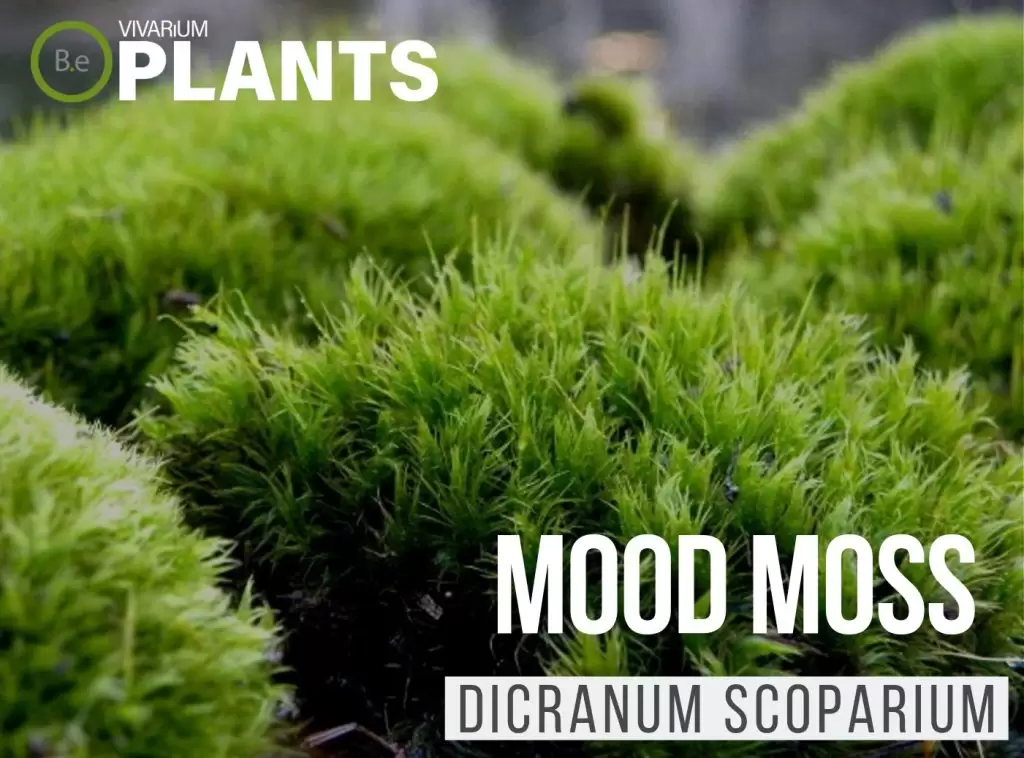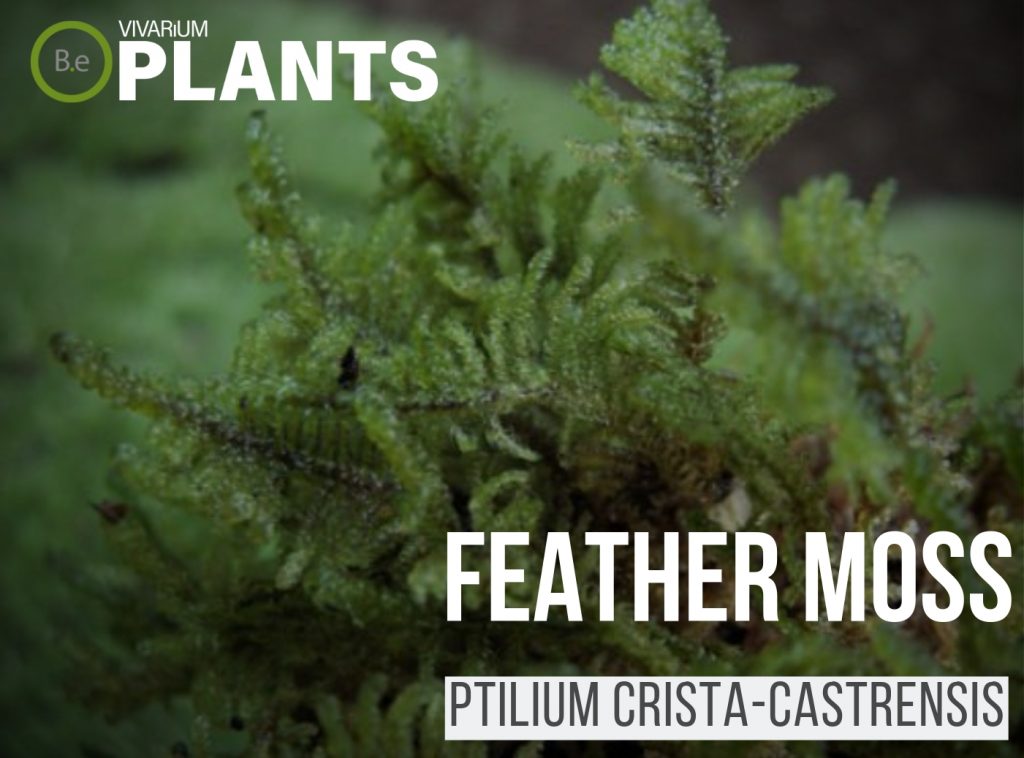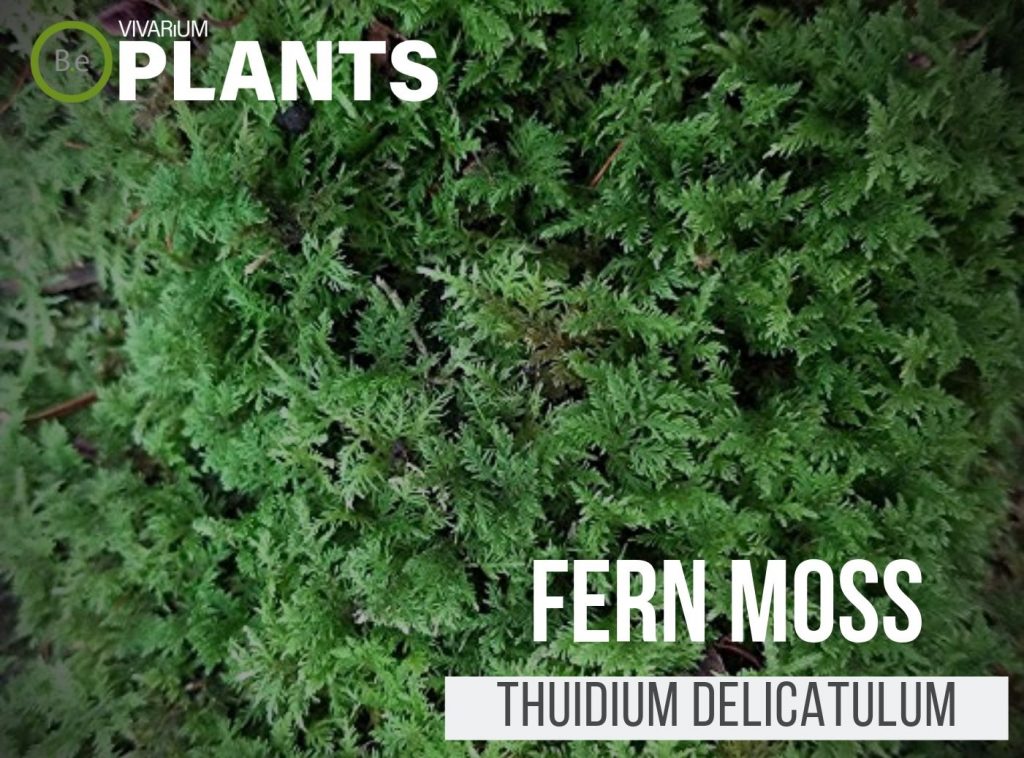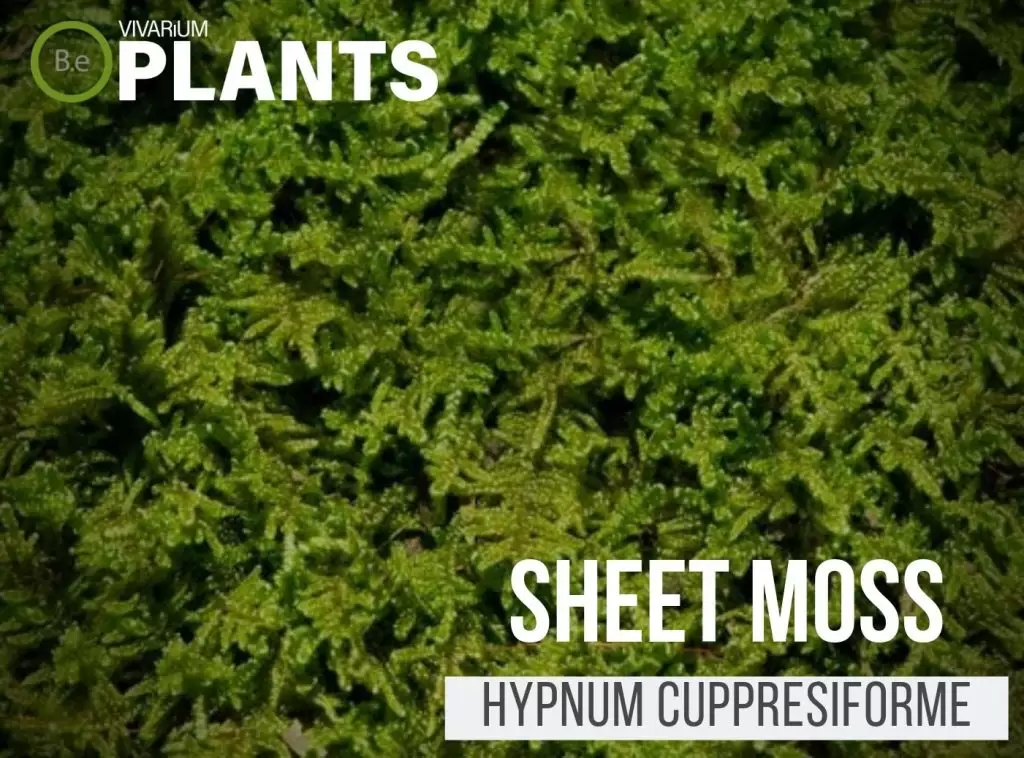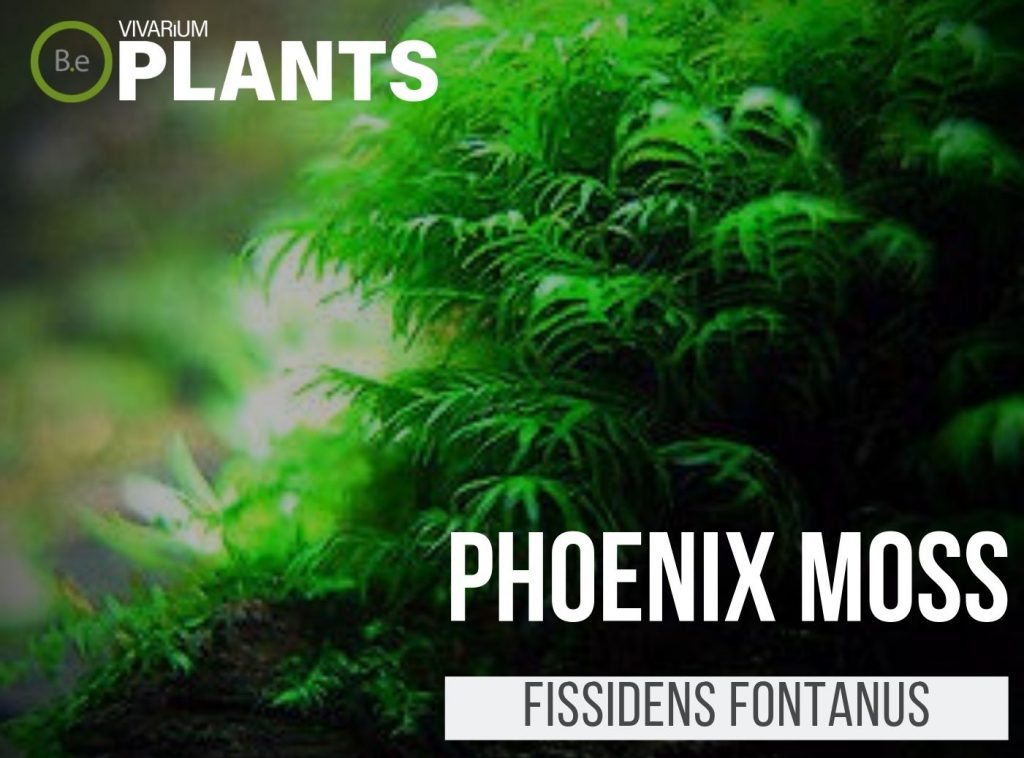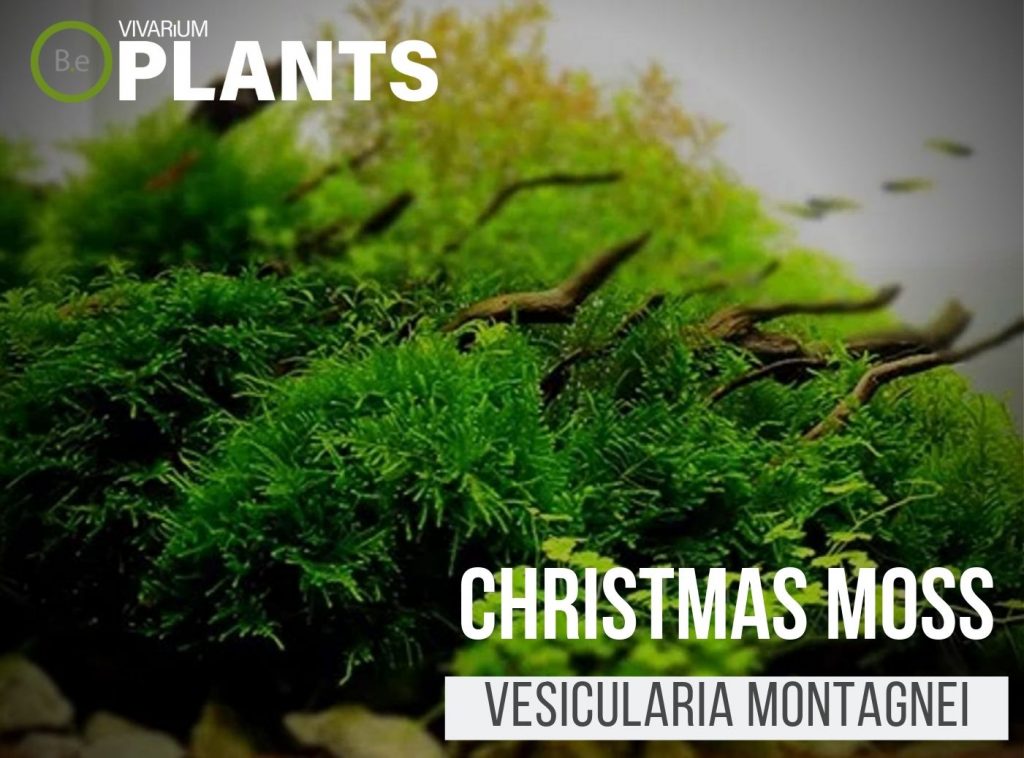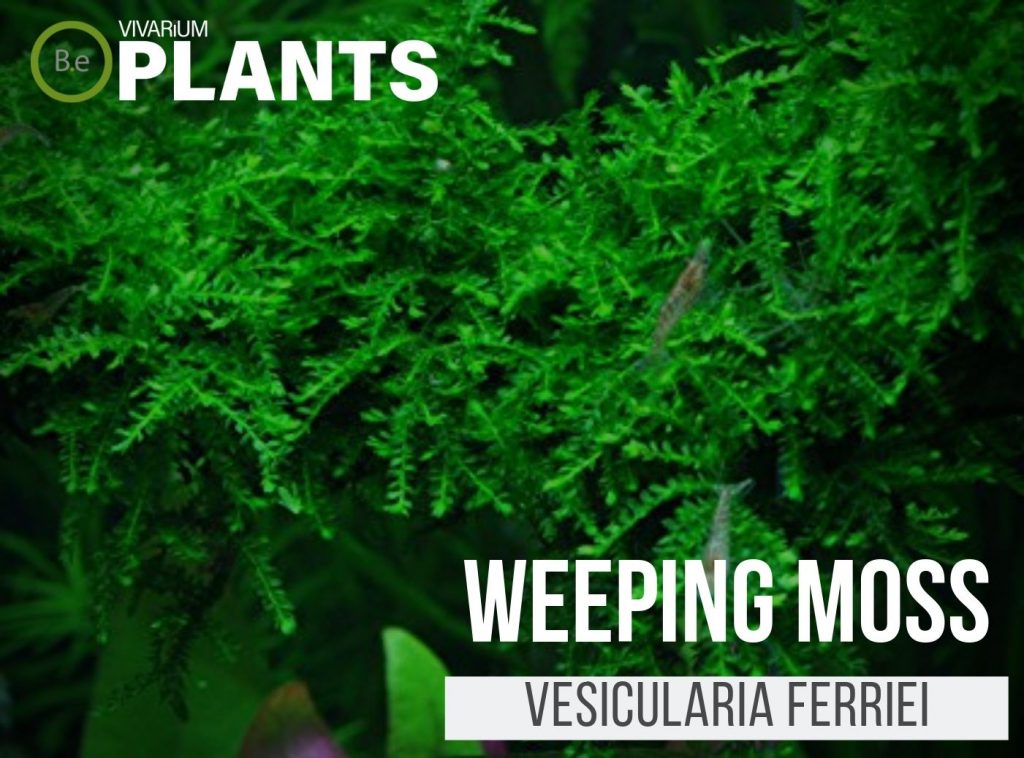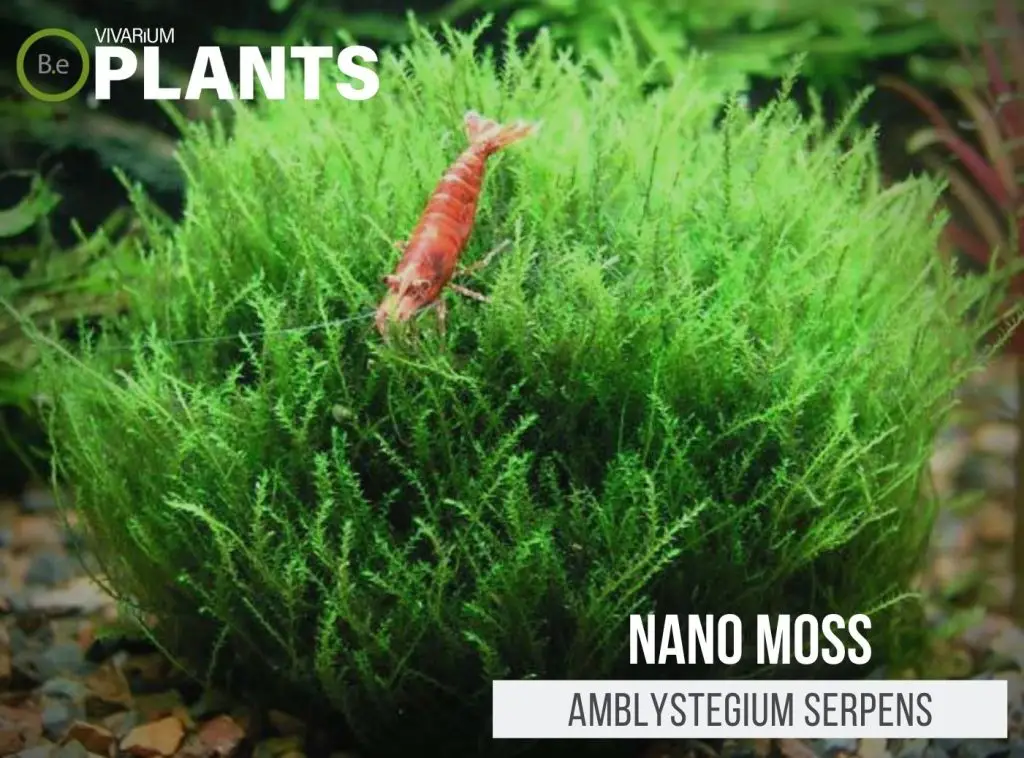There are over 20,000 documented species of bryophytes (moss, liverworts & hornworts) known today… Kind of mind-blowing to think about when deciding on the right carpeting plant to add to an enclosure.
With so many varieties to choose from and so many various conditions to consider when adding bryophytes to an existing ecosystem, it can absolutely be a lot to take in.
Hopefully, this article will help weed out the confusion and help assist you with making the right decisions on what vivarium moss to choose.
Vivarium Moss
Vivarium mosses are bryophytes that adapt to the living conditions of a controlled environment, like a terrarium or an aquarium.
Once these plants have fully established themselves within an enclosure, only then can they be considered vivarium plants.
Not all mosses are created equal, furthermore many are not suitable for life within a vivarium.
There are a number of very important factors a hobbyist should consider before stocking a tank with any type of moss-like plant.
Before diving into an in-depth list of possible mosses to consider for a vivarium.
Here are those important factors one should be aware of when contemplating the possession of carpeting plants:
What Are Bryophytes?
Bryophytes are green nonvascular plants that do not produce flowers.
They can be broken down into three groups of plants…
Mosses, Liverworts, Hornworts.
I considered including liverworts and hornworts in this vivarium moss article because they have many of the same characteristics as moss.
Furthermore, they are often marketed and sold as vivarium moss in today’s industry.


Bryophytes all generally like the same moist, high-humidity type of environment.
The growth pattern, root structure, and propagation process are also very similar to one another.
I will explain a little further to get a better idea of what I mean.
The Growth Pattern
The growth pattern of vivarium moss can be summed up into two categories, Acrocarpous or Pleurocarpous.
Understanding the growth pattern of moss is very important when considering how it will look in an enclosure.
We have to be mindful of how the plants will fill out the vivarium as they grow when initially planting them.
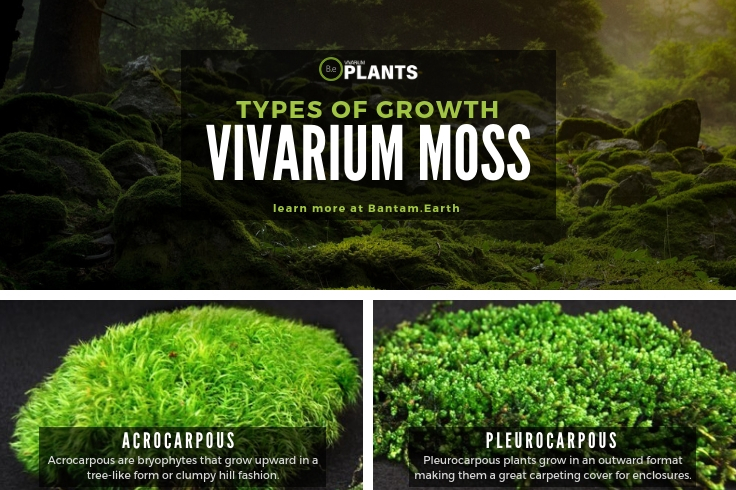

Acrocarpous are bryophytes that grow upward in a very tree-like form.
Hornworts, for example, will grow in a very narrow, upward pattern.
So it will only make sense to place this type of plant toward the background of an aquarium and prune it back as it gets taller.
Pleurocarpous plants grow in an outward format making them an excellent plant to use as a carpeting cover for enclosures.
Most of the popular moss in this list are pleurocarpous plants.
These generally don’t grow very tall but will overtake the surrounding area of an environment if resources are available.
The pruning phase for these plants will be to keep them from covering too much real estate horizontal-wise.
The Root Structure
The root structure of a bryophyte is another essential part of the plant all should have a basic understanding of.
Most mosses don’t, in fact, have a traditional root system.
They have tiny hand-like growths called rhizoids.
Understanding the difference in the nature of moss roots will ensure the longevity of a healthy vivarium moss.
Rhizoids don’t supply bryophytes with nutrients as traditional roots do in vascular plants.
The only function of moss roots is to help anchor the plant to solid surfaces.
This root structure allows moss-like plants to thrive without a substrate and anchor to more areas of a vivarium like stones, wood, and even walls.
If you are wondering at this point, how in the world does a moss receive nutrients if it does not use its roots… You are gonna love this.
Bryophytes absorb their nutrients through their leaf-like structures called phyllids.
This is why moss-like plants MUST be kept in extremely damp surroundings or fully submerged in water.
Any lack of moisture in the air and bryophytes will quickly dry out.
The Propagation Process
The third and more than likely, most sought-after aspect of vivarium moss is the propagation cycle and growing process.
Bryophytes have two forms of reproduction… Asexual and sexual.
Depending on the type of moss, weather, and environmental conditions, this plant will reproduce and grow at a given rate on its own.
Asexual reproduction occurs whenever a portion of the moss that contains at least the stem is broken off from the main bunch and put in a thriving location.
This is why I recommend breaking moss into pieces when trying to propagate a new culture.
This survival technique that bryophytes have developed makes this type of plant a good choice for beginner hobbyists.
Sexual reproduction, on the other hand, happens in intervals when the plant produces reproductive parts.
If you’ve ever noticed narrow brown stems sprout from a cluster of vivarium moss, that means it’s already mated and ready to release its spores for new colonies to begin growing.
This phenomenon occurs naturally between two bryophytes of the opposite sex… Or on one cluster of moss of the same sex.
Types Of Vivarium Moss
When it comes to moss, there are so many varieties available on the vivarium market that it wouldn’t do justice not to split them up.
The best kinds of true vivarium mosses are either aquatic, terrestrial or a combination of both (marginal).
With that in mind, a hobbyist has vast amounts of options when it comes to dressing an enclosure with mosses.
Terrarium Moss Types
Terrarium mosses are the terrestrial version of the plant that thrives above the flowing water.
These types of terrarium plants are suitable in water for short periods of time but will ultimately do much better in damp substrates with good airflow.
There are a variety of eligible mosses that will thrive in any location above the aquatic line.
Below is a complete list of terrarium moss to choose from:
Tree Moss (Climacium dendroides)
Climacium dendroides are a beautiful tree-like plant to have in a terrarium. It offers a special look that not many other mosses can match.
This moss will help to create a moist and humid atmosphere in any tank.
As well as provide an amazing refuge for small critters to find shelter within or around.
This particular tree moss is native to deciduous and coniferous forests in the northern hemisphere, specifically in temperate regions.
Tree moss flourishes in areas with adequate moisture and where the temperatures are fairly mild.
Mood Moss (Dicranum scoparium)
Dicranum scoparium is a very common terrain base plant among enthusiasts.
With damp soil and moderate levels of humidity, this moss creates lushes hills of greenery that will accent nicely to all types of vivariums.
Mood moss is not a good plant to leave in standing water and prefers higher elevation towards dryer areas of an enclosure.
When it comes to water parameters, the more acidic the better.
This type of moss could be used as a carpeting plant but looks best when used as an accenting plant placed around the base of bigger plants or hardscapes.
In the wild, Mood moss is found in shaded woodlands and forests. Preferable lighting for this plant would be low to moderate lighting.
Think cool blue cloudy day when picking lights for mood moss. Avoid UV lighting and direct sunlight at all costs.
Furthermore, Avoid long periods of dryness with this moss.
This is not a plant I’d recommend for beginner hobbyists but with a little patience and understanding, this plant will thrive!
Peat Moss (Sphagnum moss)
Sphagnum moss could easily be placed in both aquatic and nonaquatic categories. This is easily the hardest plant on this list.
Sphagnum can be used as a live plant or a dead plant (hence the common name peat moss).
There are so many benefits to sphagnum moss: it’s strong enough to lower water PH on its own when used as a filter…
Retain large amounts of water and provide moisture when used as a substrate for other plants… Or just used as an additional plant inhabiting a tank.
The natural habitat for Sphagnum moss is wetlands or peatlands so this makes it more of a marginal plant than a terrestrial one.
Greener species of this plant prefer shaded lighting and no indirect sunlight.
When placed in an enclosure as a live plant, lighting should be moderately bright resembling a well-lit cloudy day.
This is an excellent plant for all hobbyists but should be used with pets that appreciate the lower PH levels this moss will bring the environmental elements to.
Feather Moss (Ptilium crista-castrensis)
Ptilium crista-castrensis is a great moss to use as a carpeting moss in terrariums. It seamlessly creeps along all types of surfaces making it ideal for vivarium walls.
Feather moss is durable enough for all types of temperatures so if you are someone living in a colder climate, this plant will survive below-freezing temperates if it needs to.
Feather moss is one of the dryer bryophytes, avoid placing this plant in or around standing water.
It does prefer damp surfaces and moderately high levels of moisture.
This is a forest-based moss so artificial lighting should reflect that of shaded woods.
PH levels of the water-nourishing feather moss should be very acidic, ranging between five and six.
With this moss typically lathing across surfaces higher than ground level, like wood bark and stone, a fogger or some type of mister would be recommended to help the whole flora receive nutrients.
Club Moss (Selaginella kraussiana)
Selaginella kraussiana is a very popular moss to use in mossariums due to its carpeting capabilities and unique look.
This plant is typically found covering the damp grounds of woods in the mainlands of Africa.
Its hardiness makes it suitable for a wide array of temperatures but it typically thrives in areas around the low 70s.
Being a terrestrial moss, selaginella should be kept above water in parameters high in acidity.
The fern-like appearance of this moss makes it a great addition to any forest-themed vivarium.


Like most forest-dwelling mosses, the lighting should resemble a shaded tree-smothering environment.
I personally love to see this plant used in the foreground area of an enclosure as it really adds depth and scale to smaller tanks.
Substrates should be kept damp and well-drained at all times in order for this plant to see its fullest potential.
Club moss can grow as tall as eight inches if not kept groomed so be mindful if the enclosure being used is relatively small in size.
Star Moss (Tortula ruralis)
Tortula ruralis is an extravagant moss to see when used in a vivarium.
This exotic-looking piece makes a nice centerfold of its own when not being paired with other plants.
Star moss is often mistaken for aquatic moss due to it often being sold from aquariums in local stores.
The fact is, this plant may survive fully submerged for a period of time, it is an actual terrestrial moss.
The ability to survive a number of conditions besides long periods of being kept underwater makes it a rather hardy plant.


When environmental conditions become unbearable for this plant, it has the ability to go dormant until better living circumstances surface.
Star moss can also withstand a number of lighting scenarios.
It can tolerate direct sunlight as well as indirect sunlight for a period of time but should generally be kept in low-light settings for optimal health.
Ideal PH levels should range from acidic to moderately alkaline for star moss to propagate.
Delicate Fern Moss (Thuidium delicatulum)
Thuidium delicatulum is the ultimate carpeting moss for anyone looking to replicate a miniature forest vivarium.
As the name implies, fern moss resembles that of fern plants.
This moss is a plant that should undoubtedly be kept out of the water as it is a terrestrial moss but does need to be around high levels of humidity in order to thrive.
PH levels are similar to most mosses being preferably acidic when it comes to fern moss.
Even though this plant may seem like it would like dry locations, the natural habitat of Thuidium is a damp, moist wetland.
Lighting for delicate fern moss is ideally low, mimicking a cloudy day or shaded forest.
This is a colder climate plant that enjoys temperatures around the mid-sixties but it can tolerate slightly warmer temperatures periodically.
Thuidium Delcatulum is a really rewarding plant to have when given proper treatment.
It may not be the easiest to care for though so just a precaution for beginner enthusiasts.
Sheet Moss (Hypnum cupresiforme)
Sheet moss is very often sold in a preserved state for decoration in fairy gardens and small terrariums.
Not many realize the live version of this plant can do quite well in vivariums too.
Its surge in popularity is mostly due to the fact that this moss can be found on just about every continent in the world except Antarctica…
It can handle a wide array of temperatures and water parameters…
And give off an aesthetically appealing look even in its dormant stage.
Hypnum cupresiforme is a Terrestrial moss by nature, so it will not do well sitting in or fully submerged in water for a period of time.
Like most other bryophytes, this plant likes damp soil and should always be placed in an area that is well-drained to prevent dormancy or mold.
This moss is an excellent plant for beginner hobbyists.
Aquarium Moss Types
Aquarium mosses are the aquatic version of the plant.
The ideal location for this plant will predictably be fully submerged or partially immersed in flowing water.
These groups of mosses may survive above ground for a short period of time depending on the amount of humidity circulating.
Below is a complete list of aquarium moss to choose from:
Java Moss (Taxiphyllum barbieri)
Java moss might be the most popular aquatic moss on this list. With its beginner-friendly nature and simple-to-propagate standards, there’s no question as to why it shouldn’t be a common household vivarium moss.
Besides being a great plant for hobbyists, inhabitants also enjoy java moss in aquatic enclosures.
This plant provides security for smaller critters to find comfort and a source of food for many others.
Taxiphyllum can tolerate a wide array of water parameters ranging from highly acidic to moderately alkaline PH.
This moss will not typically grow taller than about 4 inches making it great for vivariums of all sizes.
It is a pleurocarpous plant so it makes a great carpeting plant to grow in freshwater aquariums.
Taxiphyllum barbieri is one of the faster-growing plants on this list as well so pruning will undeniably be required to keep the enclosure looking appealing.
Being a bottom-dwelling flora, java doesn’t require and actually prefers low-light settings.
String lights are only recommended for tanks that have very deep water heights.
Phoenix Moss (Fissidens fontanus)
Fissidens fontanus is another vibrant moss to enjoy in an aquatic vivarium.
This plant gets up to five inches long and makes a great centerfold piece when not used as a carpeting moss.
Phoenix Moss is a great home for pets sharing the enclosure to inhabit.
Recommended water parameters for this flora range from five to eight PH making it suitable for most freshwater aquariums.
This moss easily attaches to substrates and other natural surfaces and can handle abuse from tank mates and high water flows.
Phoenix moss is a fairly fast grower able to reproduce and spread horizontally faster than most moss on this list.
It does not require a high amount of lighting and actually prefers low lights being a bottom-dwelling plant.
Fissidens are known for growing in the freezing mountains so they can handle a wide range of temperatures.
When it comes to anchoring this plant, it does a better job latching on to wood and stones than substrates due to its weak rhizoid structure.
Christmas Moss (Vesicularia montagnei)
Despite its name, Christmas moss is great to use all year round as a vivarium moss.
All jokes aside, the common name came from the fact this moss does resemble a Christmas tree as it grows its stems out.
Being a fully aquatic plant, it makes a great source of food for tank mates sharing the enclosure.
Typical water parameters will range from highly acidic to just over neutral PH.
This freshwater moss has a very interesting effect on its environment aesthetically and looks great when used in the foreground as well as the background area of the tank.
Vesicularia montagnei grows to be about four inches tall and usually shoots its stems outward making it a great carpeting plant.
Ideal lighting conditions for Xmas moss are in the mid-range since it would typically grow in shallow waters in the wild.
Much like Phoenix moss, this plant will have trouble anchoring to the substrate and would be much more effective if mounted to the hardscape instead.
Flame Moss (Taxiphyllum sp.)
Flame moss is a rather new plant to the hobby that often gets confused with Java moss.
Though the two mosses look at have most of the same requirements…
The easiest way to identify this plant is by the way it grows upward.
The elevated appearance of Taxiphyllum’s stem growth gives this plant the flame-like look it earned its nickname from.
The natural habitat flame moss thrives in is the freshwater river banks of southeast Asia.
Lighting should be kept low since this is a moss that would typically be at the bottom of the river.
Water temperatures range from the high sixties to the low eighties in a moderately acidic PH.
With a maximum height of about four inches, this plant will grow in all directions horizontally, making it great for carpeting aquatic floors.
Willow Moss (Fontinalis antipyretica)
Fontinalis antipyretica is another newly acquired plant for the aquascaping hobby.
This freshwater pleurocarpous plant has become a great substitute for java moss because of its similarities.
What makes willow moss stand out from other mosses like java or flame is the unique way it sprouts out its branches…
Displaying a pleasing water fountain-like cluster of stems and leaves that are noticeably larger than that of java moss.
This is a fully aquatic moss that thrives in freshwater-type environments.
The caretaking for this plant is essentially the same as it would be for Java moss.
Low to moderate amounts of artificial lighting would be recommended.
A wide range of PH levels is tolerable to willow moss making it a great plant for beginners.
This plant can be anchored down to the substrate as well as tied to a hardscape.
Once established, this moss should grow at a faster rate.
Taiwan Moss (Taxiphyllum alternans)
Taxiphyllum alternans is a triangular-shaped moss that closely resembles a smaller version of willow moss.
This is another newly discovered plant to the vivarium hobby that originated in Taiwan, hence the common name.
Watching this moss sprout new growth is very admirable and reminiscent of a fern in the way it rolls out its stems.
The natural habitat of Taxiphyllum is typical of most freshwater aquatic plants. It thrives on an acidic PH and is hardy enough to handle moderate levels of water flow.
The lighting requirements are going to be brighter than most underwater mosses and should stay around moderate illumination.
The usual location for Taiwan moss is fallen branches so tying it to the hardscape would give it a very organic look and help it latch on before spreading out horizontally.
Weeping Moss (Vesicularia ferriei)
Vesicularia ferriei is another great alternative to Java or flame moss.
With origins that trace back to China, this is a fully aquatic plant that does best in freshwater builds.
The recommended water parameters for this moss range from hard acidic to moderate alkaline.
Since hitting the market, weeping moss has slowly begun to grow in popularity.
With it having so many characteristics to other mosses of similar look, the easy maintenance and care have made this a very sought-after plant for beginners.
When setting up lighting for this moss, keep in mind that it can handle wavelengths on the low end of the scale as well as the medium range.
Vesicularia can be tied down onto a hardscape or left floating as it naturally would in the wild.
Nano Moss (Amblystegium serpens)
Amblystegium serpens is a rare one to come across, and for good reason.
Its uniquely miniature stem structure makes it ideal for nano setups.
This moss does best in slightly acidic soils with a pH that ranges from 4.5 to 6.0.
Too alkaline of a soil environment will prevent optimal growth.
Nano moss grows very quickly in the right conditions and can form a dense spread on any premade texture.
The texture of its leaves is unique, its leaves being both wrinkled and smooth depending on growing conditions.
Within the vivarium hobby, it is common to find this type of moss used in both aquatic enclosures as well as terrariums.
Vivarium Moss-Like Plants
Now that we’ve covered the essentials of vivarium moss, you have a basic understanding of bryophytes and how to manage them in your enclosure.
Let’s break down the possible types of bryophytes that will do well in all types of vivarium.
This list will cover moss-like plants that we find are more than suitable for a controlled environment:
Hornworts
Hornworts are great starter plants for aquariums.
Even though there are over 300 documented species of hornwort known, the most common species used in the hobby are the aquatic versions of the plant.
The notable difference between hornworts and the other two bryophytes is their appearance.
The leaves on this plant are narrow and tube-like.
Coontails (Ceratophyllum demersum)
As the name suggests, coontails have a very fluffy tail shape to them.
Coontail does best fully submerged in freshwater.
Ideal PH levels range from slightly acidic to alkaline making this plant extremely hardy.
This beginner-friendly plant is a fast grower and can get as tall as 3 feet.
Ceratophyllum demersum thrives in full sun so bright lighting and a clear tank are highly recommended.
This plant can either be buried in a substrate or left floating.
Either way, this invasive flora will find a way to continue stretching across any vivarium.
Pruning will be a must in order to keep coontail from overpowering the enclosure.
Liverworts
Liverworts are even closer in relatability to mosses than hornworts.
These moss-like plants are great for all types of vivariums and are relatively easy to care for.
There are over 9000 known species of liverworts making it the second-largest group out of the three types of bryophytes.
The typical appearance of this plant is lobe-shaped leaves closely resembling a human liver.
Liverwort (Monosolenium tenerum)
Monosolenium tenerum, or simply put, liverwort is a great carpeting plant for aquariums.
Being heavier and more sturdy than other bryophytes of a similar type, This plant can do slightly better with tank inhabitants.
Preferable PH levels for liverwort will range in the more acidic side but can tolerate neutral as well as alkaline water conditions.
This plant will grow as tall as 4 inches high.
Liverwort generally thrives in low light conditions but can tolerate moderate lighting if placed in more shallow water.
This freshwater plant does best anchored to substrates, wood, or stone.
When considering a location for this moderate grower, avoid high levels of water flow.
Liverwort has the tendency to break apart easily and will make quite a mess if not placed in low-flowing water.
Crystalwort (Riccia fluitans)
With Riccia fluitans being a mostly aquatic plant, it is becoming more and more common to see this unique plant used in terrariums and fairy gardens.
Crystalwort is a lighter and more delicate version of the traditional liverwort plant.
Don’t expect this plant to grow much above water when used as decoration in dry enclosures.
This freshwater-dependent liverwort thrives in acidic to neutral water parameters but will tolerate PH levels as high as eight.
Crystalwort can be used as a floating plant as well as a carpeting plant.
The delicacy of this type of liverwort makes it a little challenging to keep anchored to substrates when paired with some inhabitants.
Avoid high levels of water flow with this flora as well for that very reason.
Riccia does best in low-lighting environments but is also pretty tolerable to brighter lights when floating to the surface.
In Summary
When browsing this list of possible bryophytes to stock your enclosure with, be conscious of the potential plant’s needs and the type of enclosure being built for it.
Understanding a few vital aspects of this flowerless plant will make the difference in having a successfully established tank.
Don’t restrict your creativity by trying to plant in the suggested vivarium type (aquatic plants for aquariums and nonaquatic plants for terrariums).
These plants will easily thrive in multi-featured enclosures like paludariums and ripariums.
For those interested in building a moss-only type of vivarium, be sure to check out the mossarium guide.
The possibilities are endless with the types of moss terrariums an enthusiast could design with moss-only vivariums!


